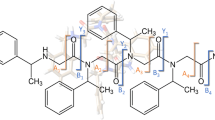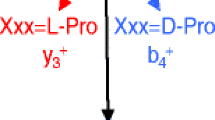Abstract
The mechanism of the cleavage of protonated amide bonds of oligopeptides is discussed in detail exploring the major energetic, kinetic, and entropy factors that determine the accessibility of the bx-yz (Paizs, B.; Suhai, S. Rapid Commun. Mass Spectrom. 2002, 16, 375) and “diketopiperazine” (Cordero, M. M.; Houser, J. J.; Wesdemiotis, C. Anal. Chem. 1993, 65, 1594) pathways. General considerations indicate that under low-energy collision conditions the majority of the sequence ions of protonated oligopeptides are formed on the bx-yz pathways which are energetically, kinetically, and entropically accessible. This is due to the facts that (1) the corresponding reactive configurations (amide N protonated species) can easily be formed during ion excitation, (2) most of the protonated nitrogens are stabilized by nearby amide oxygens making the spatial arrangement of the two amide bonds (the protonated and its N-terminal neighbor) involved in oxazolone formation entropically favored. On the other hand, formation of y ions on the diketopiperazine pathways is either kinetically or energetically or entropically controlled. The energetic control is due to the significant ring strain of small cyclic peptides that are co-formed with y ions (truncated protonated peptides) similar in size to the original peptide. The entropy control precludes formation of y ions much smaller than the original peptide since the attacking N-terminal amino group can rarely get close to the protonated amide bond buried by amide oxygens. Modeling the bx-yz pathways of protonated pentaalanine leads for the first time to semi-quantitative understanding of the tandem mass spectra of a protonated oligopeptide. Both the amide nitrogen protonated structures (reactive configurations for the amide bond cleavage) and the corresponding bx-yz transition structures are energetically more favored if protonation occurs closer to the C-terminus, e.g., considering these points the Ala(4)-Ala(5) amide bond is more favored than Ala(3)-Ala(4), and Ala(3)-Ala(4) is more favored than Ala(2)-Ala(3). This fact explains the increasing ion abundances observed for the b2/y3, b3/y2, and b4/y1 ion pairs in the metastable ion and low-energy collision induced mass spectra (Yalcin, T.; Csizmadia, I. G.; Peterson, M. B.; Harrison, A. G. J. Am. Soc. Mass Spectrom. 1996, 7, 233) of protonated pentaalanine. A linear free-energy relationship is used to approximate the ratio of the bx and yz ions on the particular bx-yz pathways. Applying the necessary proton affinities such considerations satisfactorily explain for example dominance of the b4 ion over y1 and the similar b3 and y2 ion intensities observed for the metastable ion and low-energy collision induced mass spectra.
Similar content being viewed by others
References
Fenn, J. B.; Mann, M.; Meng, C. K.; Wong, S. F.; Whitehouse, C. M. Electrospray Ionization for Mass-Spectrometry of Large Biomolecules. Science 1989, 246, 64.
Karas, M.; Hillenkamp, F. Laser Desorption Ionization of Proteins with Molecular Masses Exceeding 10,000 Da. Anal. Chem. 1988, 60, 2299.
Roepstorff, P.; Fohlman, J. Proposal for a Common Nomenclature for Sequence Ions in Mass Spectra of Peptides. Biomed. Mass Spectrom. 1984, 11, 601.
Biemann, K. Contributions of Mass Spectrometrey to Peptide and Protein Structure. Biomed. Env. Mass Spectrom. 1988, 16, 99.
Mann, M.; Wilm, M. Error-Tolerant Identification of Peptides in Sequence Databases by Peptide Sequence Tags. Anal. Chem. 1994, 66, 4390.
Eng, J. K.; McCormack, A. L.; Yates, J. R. III. An Approach to Correlate Tandem Mass Spectra Data of Peptides with Amino Acid Sequences in a Protein Database. J. Am. Soc. Mass Spectrom. 1994, 5, 976.
Perkins, D. N.; Pappin, D. J. C.; Creasy, D. M.; Cottrell, J. S. Probability-Based Protein Identification by Searcheing Sequence Databases Using Mass Spectrometry Data. Electrophoresis 1999, 20, 3551–3567.
Clauser, K. R.; Baker, P. R.; Burlingame, A. L. Role of Accurate Mass Measurement (+/− 10 ppm) in Protein Identification Strategies Employing MS or MS MS and Database Searching. Anal. Chem. 1999, 71, 2871.
Baer, T.; Hase, W. L. Unimolecular Reaction Dynamics; Oxford University Press: Oxford, 1996.
Frisch,, M. J. Gaussian-98, Rev. A9. Gaussian, Inc.: Pittsburgh PA, 1995.
Dongré, A. R.; Jones, J. L.; Somogyi, Á.; Wysocki, V. H. Influence of Peptide Composition, Gas-Phase Basicity, and Chemical Modification on Fragmentation Efficiency: Evidence for the Mobile Proton Model. J. Am. Chem. Soc. 1996, 118, 8365.
Harrison, A. G.; Yalcin, T. Proton Mobility in Protonated Amino Acids and Peptides. Int. J. Mass Spectrom. Ion Processes 1997, 165/166, 339.
Csonka, I. P.; Paizs, B.; Lendvay, G.; Suhai, S. Proton Mobility in Protonated Peptides: A Joint Molecular Orbital and RRKM Study. Rapid. Commun. Mass Spectrom. 2000, 14, 417.
Paizs, B.; Csonka, I. P.; Lendvay, G.; Suhai, S. Proton Mobility in Protonated Glycylglycine and N-Formylglycylglycinamide: A Combined Quantum Chemical and RKKM Study. Rapid Commun. Mass Spectrom. 2001, 15, 637.
Paizs, B.; Suhai, S. Theoretical Study of the Main Fragmentation Pathways for Protonated Glycylglycine. Rapid Commun. Mass Spectrom. 2001, 15, 651.
Paizs, B.; Suhai, S. Combined Quantum Chemical and RRKM Modeling of the Main Fragmentation Pathways of Protonated GGG. I. Cis-trans Isomerization Around Protonated Amide Bonds. Rapid Commun. Mass Spectrom. 2001, 15, 2307.
Paizs, B.; Suhai, S. Combined Quantum Chemical and RRKM Modeling of the Main Fragmentation Pathways of Protonated GGG. II. Formation of b2, y1, and y2 Ions. Rapid Commun. Mass Spectrom. 2002, 16, 375.
Cordero, M. M.; Houser, J. J.; Wesdemiotis, C. The Neutral Products Formed During Backbone Fragmentations of Protonated Peptides in Tandem Mass Spectrometry. Anal. Chem. 1993, 65, 1594.
Yalcin, T.; Khouw, C.; Csizmadia, I. G.; Peterson, M. R.; Harrison, A. G. Why are b Ions Stable Species in Peptide Spectra?. J. Am. Soc. Mass Spectrom. 1995, 6, 1165.
Yalcin, T.; Csizmadia, I. G.; Peterson, M. B.; Harrison, A. G. The Structure and Fragmentation of B n (n ≧ 3) Ions in Peptide Spectra. J. Am. Soc. Mass Spectrom. 1996, 7, 233.
Nold, M. J.; Wesdemiotis, C.; Yalcin, T.; Harrison, A. G. Amide Bond Dissociation in Protonated Peptides. Structures of the N-terminal Ionic and Neutral Fragments. Int. J. Mass Spectrom. Ion Processes 1997, 164, 137.
Polce, M. J.; Ren, D.; Wesdemiotis, C. Dissociation of the Peptide Bond in Protonated Peptides. J. Mass Spectrom. 2000, 35, 1391.
Paizs, B.; Lendvay, G.; Vékey, K.; Suhai, S. Formation of b2/+ Ions from Protonated Peptides: An ab Initio Study. Rapid Commun. Mass Spectrom. 1999, 13, 525.
Paizs, B.; Suhai, S. Towards Understanding Some Ion Intensity Relationships for the Tandem Mass Spectra of Protonated Peptides. Rapid Commun. Mass Spectrom. 2002, 16, 1699.
Harrison, A. G. Linear Free Energy Correlations in Mass Spectrometry. J. Mass Spectrom. 1999, 34, 577.
Csonka, I. P.; Paizs, B.; Lendvay, G.; Suhai, S. Proton Mobility and Main Fragmentation Pathways of Protonated Lysylglycine. Rapid. Commun. Mass Spectrom. 2001, 15, 1457.
Jegorov, A.; Paizs, B.; Zabka, M.; Kuzma, M.; Giannakopulos, A. E.; Derrick, P. J.; Havlicek, V. Profiling of Cyclic Hexadepsipeptides Roseotoxins Synthesized in Vitro and in Vivo: A Combined Tandem Mass Spectrometry and Quantum Chemical Study. Eur. J. Mass Spectrom. 2003, 9, 105.
Paizs, B., Suhai, S., Harrison, A. G. Experimental and Theoretical Investigation of the Main Fragmentation Pathways of Protonated H-Gly-Gly-Sar-OH and H-Gly-Sar-Sar-OH, in press.
Campbell, S.; Rodgers, M. T.; Marzluff, E. M.; Beauchamp, J. L. Deuterium Exchange Reactions as a Probe of Biomolecule Structure. Fundamental Studies of Gas Phase H/D Exchange Reactions of Protonated Glycine Oligomers with D2O, CD3OD, CD3CO2D, and ND3. J. Am. Chem. Soc. 1995, 117, 12840.
Paizs, B.; Lendvay, G.; Suhai, S. Towards Understanding the Mechanism of Gas Phase Hydrogen/Deuterium (H/D) Exchange Reactions of Protonated Peptides I. Reactions of Protonated Clycylglycine with D2O, unpublished
Wyttenbach, T.; Paizs, B.; Barran, P.; Breci, L.; Liu, D.; Suhai, S.; Wysocki, V. H.; Bowers, M. T. The Effect of the Initial Water of Hydration on the Energetics, Structures and H/D-Exchange Mechanism of a Family of Pentapeptides: An Experimental and Theoretical Study, in press.
Harrison, A. G. The Gas-Phase Basicities and Proton Affinities of Amino Acids and Peptides. Mass Spectrom. Rev. 1997, 116, 201.
Cassady, C. J.; Carr, S. R.; Zhang, K.; Chung-Phillips, A. Experimental and ab Initio Studies on Protonations of Alanine and Small Peptides of Alanine and Glycine. J. Org. Chem. 1995, 60, 1704.
Author information
Authors and Affiliations
Corresponding author
Additional information
Published online November 19, 2003
Rights and permissions
About this article
Cite this article
Paizs, B., Suhai, S. Towards understanding the tandem mass spectra of protonated oligopeptides. 1: Mechanism of amide bond cleavage. J Am Soc Mass Spectrom 15, 103–113 (2004). https://doi.org/10.1016/j.jasms.2003.09.010
Received:
Revised:
Accepted:
Issue Date:
DOI: https://doi.org/10.1016/j.jasms.2003.09.010




